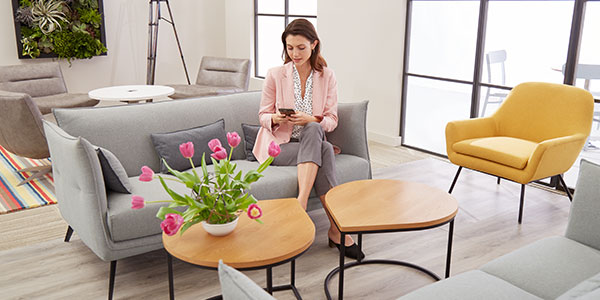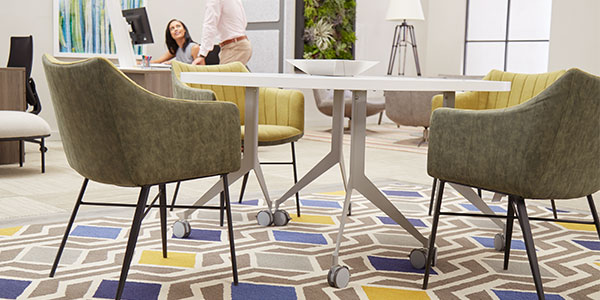By: Melanie Jones, CORT Workplace Business Development Executive
It’s no longer speculation, but a fact: Space as a Service (SPaas) is driving significant change in what used to be the somewhat predictable and steady world of the commercial real estate industry (CRE). This paradigm shift has essentially altered the role of CRE landlords from simply collecting rent to providing their space as an ongoing, managed service.
This change has necessitated a drastic shift in the way CRE professionals utilize their available space. At CORT, my colleagues and I spend much of our time helping clients and commercial real estate teams navigate through the changes that have come about as a result of the rise in demand for flexible spaces.
To meet the needs of this evolving market, CORT’s Furniture-as-a-Service (Faas) has proved incredibly useful. Because Space as a Service requires CRE landlords to remain agile in their offerings, FaaS — which involves accessing versus owning furniture through a subscription-like approach — it allows buildings and the people who work and manage them to use furniture as a flexible tool rather than a stagnant asset.
After working with multiple clients, I’ve found there are four tactics that effectively combine flex space with FaaS. These hacks have provided positive and measurable results for CRE professionals looking to capture revenue from this move toward Space as a Service.
1. Lobbies and Amenities

Remember the days when extravagant lobbies were dressed to impress? Well, times have changed.
Now, these prized first floor spaces are ideal to create the amenity areas that clients demand. As mobility continues to drive how and where we work, touching down while on the go is critical. The quiet lobbies of yesterday have exchanged their opulence for busy, trendy and ever-changing touchdown spaces and communal gathering areas.
For commercial properties looking to convert these valuable square feet into a revenue-generating space, FaaS can come in quite handy. With Furniture as a Service, these lobbies can be filled with furniture that changes with the seasons, and that can be switched out as desired to create a sense of newness and life.
2. Flex-Spaces

My colleague, Ron Steinbrink, defines flex space as “a way that commercial real estate owners provide tenants access to flexible but dependable office space on a lease term of anywhere from one month to three years.” The very nature of a flexible space calls for flexible assets, and that’s where FaaS comes in.
As the popularity of coworking has grown, office buildings have moved toward creating options beyond coworking — specifically for mid-sized and growing firms. In some instances, building ownership and landlord teams are banking on the Field of Dreams mindset: “if you build it and they will come.”
The good news is, this approach has seemed to work. In fact, Boston Properties tested this theory and were thrilled to lease all their available space within 30 days. In their case, the building valuation increased and not the other way around.
These flex spaces have also helped older building create a marketing hook, boosting their leasing activity. Across the US, CORT is working with clients to install short-term flex-spaces in a portion of these buildings as an added amenity. The short-term space demands a much higher square footage cost.
3. Spec Suites & Plug & Play

Spec Suites and Plug and Play spaces provide commercial real estate teams the opportunity to provide a low cost, minimal risk and flexible approach to the use of their space. With that flexibility comes the need for flexible furnishings, which is where FaaS comes into the picture.
With FaaS, building owners can outfit a vacant space with trendy furniture for a fraction of the cost of purchase. And when styles or needs change, they can switch it out, move it, or return it based on the needs of the new tenant.
A recent article in Rejournal explains how spec suites have become a powerful component in the office marketing toolbox. When office buildings offer high design spec suites that clearly demonstrate the owners are investing in the look of the space, those are the ones that stand out to tenants. As a result, these suites that make it easy for prospective tenants to say “yes,” because they can visualize the space in a more finished form.
CORT’s Furniture as a Service — which also includes space planning — helps CRE teams with renderings, pricing and offers millions and millions of dollars of inventory from which to choose.
4. Swing Space
Finally, this last hack is truly timeless. Swing space have been around since the dawn of modern office culture, and there will always be the need for these spaces because buildings are continuously changing to meet the demands of the tenant.
However, there’s a new twist on an old idea. Some firms are now utilizing coworking spaces for the traditional swing space, but there is still a great need for larger firms needing their own space during transition times. With FaaS, companies are able to set up the office and then add to it as needed. Because FaaS is fast, a 200 person site can be up and running within about ten days, and gone just as fast.
Combine FaaS and SPaaS for Optimal Results
All four of the examples here really do fall into the broader category of Space as a Service. Simply put, demand has and does drive the need for fast, flexible and well thought out space so businesses can focus more on what they do.
Melanie Jones is a regional industry leader on the CORT Furniture Rental Workplace team. Her mission is supporting change in the way furniture is used in the workplace with CORT’s Furniture as a Service.







